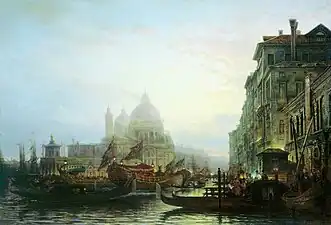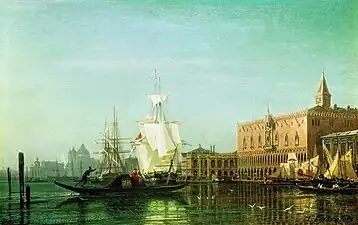Alexey Bogolyubov
Alexey Petrovich Bogolyubov (Russian: Алексей Петрович Боголюбов; 16 March 1824 – 3 February 1896) was a Russian landscape and seascape painter.
Alexey Bogolyubov | |
|---|---|
| Алексей Петрович Боголюбов | |
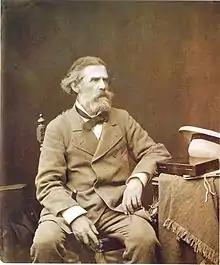 | |
| Born | March 16, 1824 |
| Died | November 7, 1896 (aged 72) |
| Education | Member Academy of Arts (1858) Professor by rank (1861) Full Member Academy of Arts (1893) |
| Alma mater | Imperial Academy of Arts (1853) |
| Known for | Painting |
| Style | landscape art |
| Movement | Peredvizhniki |
| Awards | |
Biography

by Ilya Repin
.jpg.webp)
by Vasily Vereshchagin
Bogolyubov was born in the Pomeranie village of Novgorod Gubernia. His father was retired colonel Pyotr Gavriilovich Bogolyubov. Bogolyubov's maternal grandfather was the philosopher and social critic Alexander Radishchev.[1]
In 1841, Bogolyubov graduated from military school, serving in the Imperial Russian Navy and travelling with the fleet to many countries. In 1849, he started to attend classes of the Saint Petersburg Academy of Arts, where he studied under Maxim Vorobiev. The young painter was greatly influenced by Ivan Ayvazovsky. In 1853, he finished the Academy with a major Gold medal. He retired as a navy officer and was appointed an artist to the Navy headquarters.
From 1854 to 1860, he travelled around Europe and worked prolifically. In Rome, he was acquainted with Alexander Ivanov, who convinced Bogolyubov to focus more on drawing. In Düsseldorf, Bogolyubov took classes from the painter Andreas Achenbach. In Paris, he admired the artists of the Barbizon School. French painters Camille Corot and Charles-François Daubigny were good friends and collaborators with Bogolyubov. He also painted the frescoes in the Alexander Nevsky Cathedral.
Bogolyubov returned to Russia in 1860. He exhibited his works in the Academy and received the title of professor. For some time, he taught in the Academy. In the 1860s, he traveled along the Volga. His paintings lost all traces of Romanticism, replacing that element with staunch realism of the natural. In 1871 he was elected to the Imperial Academy of Arts.
From 1870, he became close to the Wanderers art movement, participated in all their exhibitions. He became a member of their board. Much older than most of the other members of the movement, he had reservations on their social ideas. In 1873, Bogolyubov left the Academy in solidarity with his fellow Itinerants. He even tried to create an alternative Russian Academy of Arts in Rome.[1]
After 1873, Bogolyubov lived primarily in Paris, because of his heart condition. His house was like a Russian colony: frequent visitors included Ivan Turgenev, Ilya Yefimovich Repin, Vasily Polenov, Mark Antokolski, Vasili Vasilyevich Vereshchagin.[1]
In 1885, Bogolyubov opened an art museum in Saratov, the Radischev Art Museum, named after his grandfather. It was opened to the general public seven years earlier than the Tretyakov Gallery in Moscow and fifteen years earlier than the Russian Museum in Saint Petersburg.[2] The naming of the museum after the "first Russian revolutionary", Alexander Radishchev, was a direct challenge to the authorities: Bogolyubov had to endure a legal battle to get permission.
Bogolyubov died on 3 February 1896 in Paris. He left all his money and capital (around 200 thousand Russian rubles (approximately US$6 million)) to the museum and its painting school.[1] The school was opened after Bogolyubov's death and named Bogolyubov's Painting School (Боголюбовское Рисовальное Училище).[1] Among painters who attended Bogolyubov's School were such important modernist painters as Victor Borisov-Musatov, Alexei Karev and Pavel Kuznetsov.
Selection of works
- Marine art & Seascapes
![Russian squadron on its way to America [ru] in 1863](../I/%D0%A0%D1%83%D1%81%D1%81%D0%BA%D0%B0%D1%8F_%D1%8D%D1%81%D0%BA%D0%B0%D0%B4%D1%80%D0%B0_%D0%BD%D0%B0_%D0%BF%D1%83%D1%82%D0%B8_%D0%B2_%D0%90%D0%BC%D0%B5%D1%80%D0%B8%D0%BA%D1%83.jpg.webp) Russian squadron on its way to America in 1863
Russian squadron on its way to America in 1863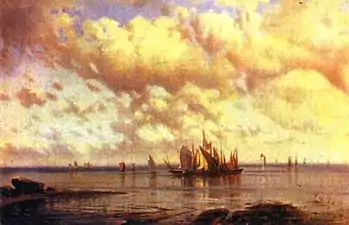 Sailing ships (1860)
Sailing ships (1860)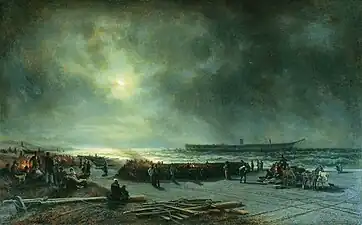 The Wreck of the Russian frigate Alexander Nevsky
The Wreck of the Russian frigate Alexander Nevsky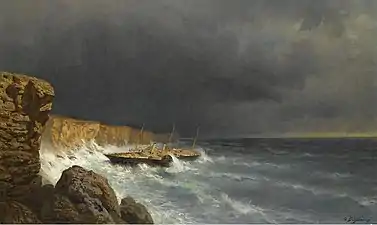 The Wreck of the Livadia
The Wreck of the Livadia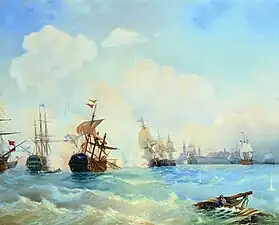 Battle of Reval in 1790
Battle of Reval in 1790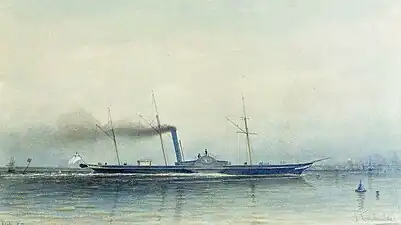 Imperial steam yacht Aleksandria of 1852
Imperial steam yacht Aleksandria of 1852.jpg.webp) The theme of two lovers meeting at sunset on the seashore near a pulwar.
The theme of two lovers meeting at sunset on the seashore near a pulwar..jpg.webp) Coastal view
Coastal view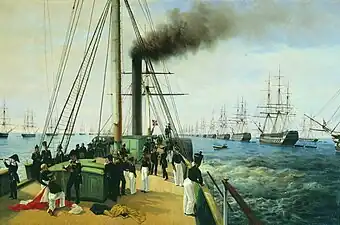
- Russian Empire
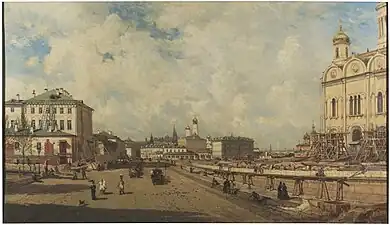
1879%252C%D0%91%D0%BE%D0%B3%D0%BE%D0%BB%D1%8E%D0%B1%D0%BE%D0%B2_%D0%90%D0%BB%D0%B5%D0%BA%D1%81%D0%B5%D0%B9_%D0%9F%D0%B5%D1%82%D1%80%D0%BE%D0%B2%D0%B8%D1%87.jpg.webp) Moscow. View of Golitsyn Hospital and Neskuchnoye in 1879.
Moscow. View of Golitsyn Hospital and Neskuchnoye in 1879. Kremlin illumination in 1883
Kremlin illumination in 1883.jpg.webp) Kazan in 1862
Kazan in 1862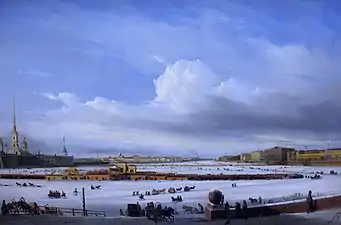 St. Petersburg, Sledging on the Neva, 1854 (full painting)
St. Petersburg, Sledging on the Neva, 1854 (full painting)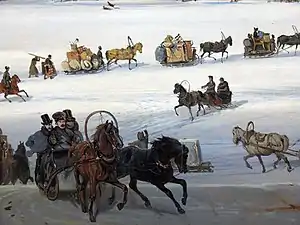 Sledging on the Neva (Detail)
Sledging on the Neva (Detail) Bolshaya Neva. The painting in 1872.
Bolshaya Neva. The painting in 1872.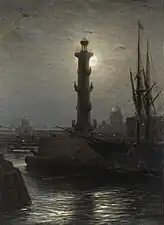
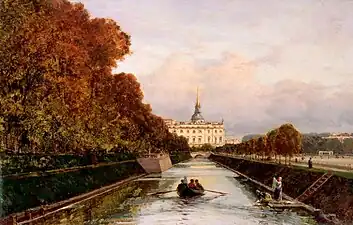 View to Saint Michael's Castle in Petersburg from Lebiazhy Canal, 1880s
View to Saint Michael's Castle in Petersburg from Lebiazhy Canal, 1880s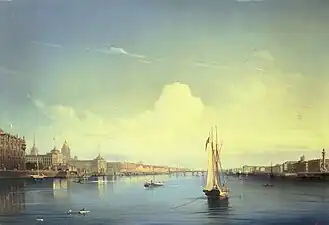 Petersburg at sunset 1850
Petersburg at sunset 1850
.jpg.webp) Fire in Kronstadt at Night, c. 1876
Fire in Kronstadt at Night, c. 1876
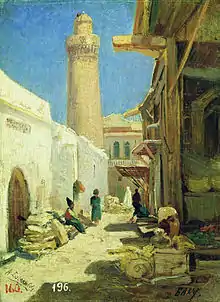 Baku. Street at noon (1861)
Baku. Street at noon (1861)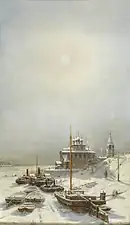 Winter in Borisoglebsk before 1902
Winter in Borisoglebsk before 1902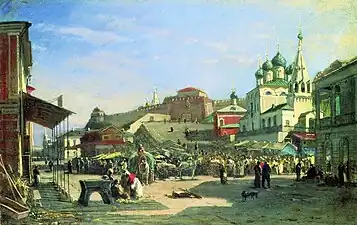 Nizhny Novgorod. Lower Bazaar (1878).
Nizhny Novgorod. Lower Bazaar (1878).
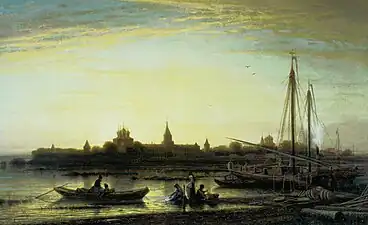 Ipatios Monastery near Kostroma, 1861
Ipatios Monastery near Kostroma, 1861![Ablyazovo [ru], 1887Radishchev Art Museum](../I/%D0%90%D0%B1%D0%BB%D1%8F%D0%B7%D0%BE%D0%B2%D0%BE._%D0%A0%D0%B0%D0%B4%D0%B8%D1%89%D0%B5%D0%B2%D1%81%D0%BA%D0%B0%D1%8F_%D1%83%D1%81%D0%B0%D0%B4%D1%8C%D0%B1%D0%B0._%D0%9E%D0%B2%D1%80%D0%B0%D0%B3.jpg.webp)

- Ottoman Empire
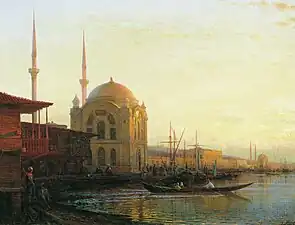 Mosque in Constantinople (1850s)
Mosque in Constantinople (1850s)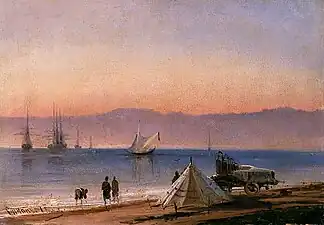 Sinop, Ottoman Turkey, 1856
Sinop, Ottoman Turkey, 1856
- France
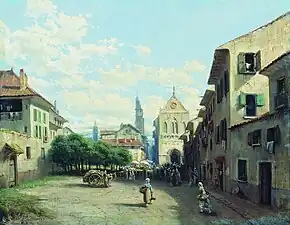 Normandy town, 1879
Normandy town, 1879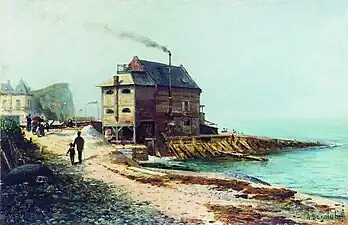 Veules-les-Roses, Normandy, French Republic, 1880
Veules-les-Roses, Normandy, French Republic, 1880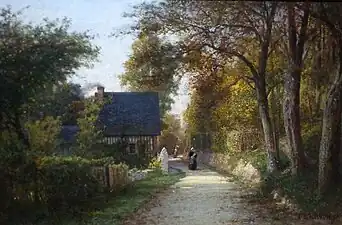 Normandy, 1870.
Normandy, 1870.
Yekaterinburg Museum of Fine Arts.jpg.webp) Moonlight at Pornic
Moonlight at Pornic
- Denmark
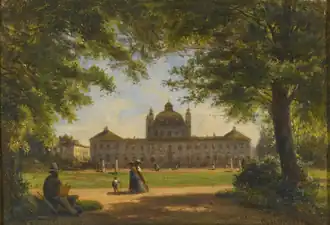 Fredensborg Palace of 1867
Fredensborg Palace of 1867
- Germany
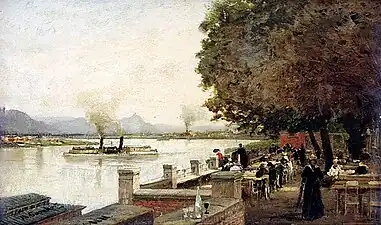
 An alley in the park. Liechtenstein. 1889.
An alley in the park. Liechtenstein. 1889.
- Czech Kingdom

- Belgium
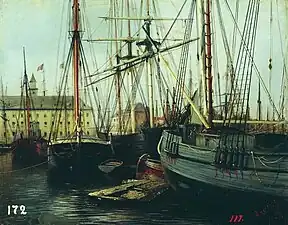 Antwerp, 1854
Antwerp, 1854
Footnotes
- Alexey Bogolyubov (in Russian) article
- Bogolyubov page on the site of Saratov Radischev Museum (in Russian)
References
- Bogoliubov. by M. I. Andronnikova. Moscow. 1962
External links
- Alexey Bogolyubov Notes of an Sailor-Artist Archived 2007-02-03 at the Wayback Machine (in Russian)
